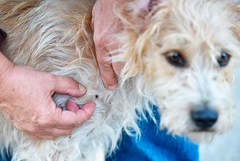How to Find Dried Dead Tick On Dog?
- 0.1 How can you find a dried tick on your dog?
- 0.2 Spots Ticks Can Be Hiding:
- 0.3 They Might Be Sticking To The Skin:
- 0.4 How Can You Remove A Dried Dead Tick On Dogs?
- 0.5 Things To Avoid While Removing A Dead Tick?
- 0.5.1 Avoid These Completely:
- 0.6 Things To Know After The Tick Is Removed:
- 0.7 Side Effects After Removing Ticks From Dog’s Skin
- 0.8 A few tips on what you should do if you discover dead ticks on your dog’s skin:
- 0.9 What Diseases Can Dogs Get From Dead Ticks?
If you’re a pet owner or dog lover, you’ll know that dead ticks that have dried on the dog’s skin can pose a major issue. The tiny creatures could attach themselves to your pet and then suck their blood, causing many different issues. One of the most unpleasant types of tick is the dead tick. It’s a tick that has died, however, its mouthparts remain inside the skin of your dog. If you spot dead, dried ticks on your pet are important to get rid of the tick as quickly as you can.
How can you find a dried tick on your dog?
Ticks are tiny, parasites that cling to the skin of their hosts to eat their blood. Ticks can trigger a range of health issues in their host, which include irritation to the skin, allergic reactions, and even infections. It is important to monitor your pet for ticks on a regular basis however, it’s sometimes difficult to identify ticks, particularly when they’re dead. Here are some tips to identify Dead ticks in dogs
Spots Ticks Can Be Hiding:
Ticks are found all over the dog’s body but they’re typically found in the following locations:
- Under the Chin
- Around and in the ear
- The side of your neck
- On the chest and belly.
- Between the toes
- Around the anus
- Between the toes
- In the armpits
- Inside the ear
- Eyelids
- Near the area of the groin
Begin by inspecting your dog’s neck, head, and ear, as these are the places where ticks are most likely to be able to attach themselves. Make use of your fingers to look for lumps or bumps that are on the pet’s skin.
Dogs’ Fur Can Be Ticks Home:
Yes, you’ll find dead ticks in your dog’s fur. Ticks are blood-sucking parasites that could connect to your dog when out on the streets. If you spot dead ticks on your pet It’s likely that the tick was in contact with your dog for a while but has since passed away. Dead ticks can be discovered on dogs’ furs but are not typically a cause for worry. We’ll guide you through the steps needed to eliminate a tick from the fur of your dog.
They Might Be Sticking To The Skin:
Last but not least, check your dog’s body for tick shells. They are the tough exoskeletons ticks shed after they’ve finished eating. If you discover tick shells, remove the ticks from your pet’s fur.
Following these steps, you will be able to find all dead ticks or ticks that could be present on the body of your dog.
Ticks can cause a serious nuisance, not just for dogs, but also for humans too. Not only can they be unpleasant and a nuisance, but they transmit disease. This is why it’s crucial to remove ticks from your dog as fast as you can.
If you spot a tick, to determine if it’s dead, begin by looking for dead skin on the tick. This is an excellent sign that the tick is dead. It is also important to be looking for any remains or dead tissue near the bite area. If you notice any of these indicators then it’s likely the tick has died. However, if you’re not sure, you may seek advice from your veterinarian.
How Can You Remove A Dried Dead Tick On Dogs?
The most effective method to remove dead ticks from your pet’s skin is to employ tweezers. Take it as near to the skin of your dog as possible, then push it upwards. When the tick has died it will be removed quickly. If you are having difficulty taking the tick off it is possible to apply a tiny amount of mineral oil or petroleum jelly to the area surrounding the tick. This will in releasing the tick’s grip from the skin, making it easier to get rid of.
After you’ve removed your dead tick, you need to dispose of it correctly. It is possible to put it into the drain or place it in a bag that is sealed prior to disposing of it. Make sure to cleanse your hands thoroughly after coming in contact with dead ticks.
If you discover dead ticks on your pet it’s not a reason to be concerned. Follow the steps below to remove it safely and in a proper manner. Be sure to always inspect your pet for ticks after you’ve gone outside!
Using Tweezers To Remove Dog Ticks:
To get rid of dead ticks from your pet, make use of tweezers and grab your tick close enough to the skin is possible. Push upwards with steady pressure until the tick releases. If you see any remains in the area of the bite do not be worried. The likelihood of getting Lyme disease through the dead tick is low to zero.
If you discover dead ticks on your pet it is important to get rid of the tick as quickly as you can. Here’s how:
- Utilize a pair of tweezers and hold your ticks as closely to the skin as you can.
- Continue to pull upwards with constant force until the tick lets go of its grip.
- Avoid damaging or crushing parts of the tick’s body which can release infectious fluids into the bloodstream of your dog.
- If there’s a trace of debris within the area of the bite, do not be concerned. The odds of getting Lyme disease through dead ticks are slim to zero.
- Cleanse the bite area with alcohol or hydrogen peroxide and then watch for any indications of infection.
Things To Avoid While Removing A Dead Tick?
There are certain items you must avoid when you remove the live ticks of your pet. First, do not use matches or cigarettes to kill ticks. This can cause the tick to release the contents of its stomach into your dog’s bloodstream, and possibly transmit diseases. Don’t attempt at removing the tick using your hands. This could increase the chance of contracting the disease. Don’t tug on the tick too strongly or twist it, as it could cause the mouthparts to split and stay inside the skin of your dog.
If you discover dead ticks on your pet, get rid of it gently using a pair of tweezers holding them as close to your pet’s skin is possible, and then pulling it up straight. After the tick has been removed, remove it in a proper manner (preferably to flush it into the bathroom) and clean all your hands well. Also, clean the area in which the tick was.
Avoid These Completely:
- Never take a dead tick by rubbing your fingers
- Do not crush the tick when taking it off.
- Do not use petroleum jelly, hot matches, or any other product to attempt to eliminate the tick. These techniques can cause irritation to your skin, making it more difficult to remove the tick.
- Be careful not to touch the tick with anything else following removal.
Things To Know After The Tick Is Removed:
Is It Common To Have A Red Bump?
The saliva of ticks has anesthetic and anticoagulant properties permitting it to feed off the blood of your dog. In the event of getting rid of a Tick and removing it, your dog could develop bumps. Based on the method used to eliminate the parasite, it may cause a large amount of saliva on the skin of your dog.
Side Effects After Removing Ticks From Dog’s Skin
Once you’ve removed the tick, the skin of your dog will likely show the following signs. These are:
- Pink or red flesh with a border
- Swollen skin.
- Loss of fur or hair.
The bite area of the tick could take 2 to 3 weeks to fully heal, but it will heal by itself and then disappear. We recommend monitoring the area where you were bitten to ensure it doesn’t get any worse.
A few tips on what you should do if you discover dead ticks on your dog’s skin:
- Do not touch the tick with anything else following removal.
- Make sure you wash your hands well after removal.
- Clean the area to which the tick was. You can clean it with soap or rubbing alcohol, along with water.
- Monitor the bite site for any indications of infection, like swelling, redness, or discharge. If you observe any of these signs immediately, consult your physician promptly.
By following these simple guidelines to help keep your dog healthy and secure! Dead ticks are not an alarm signal, but it is recommended to eliminate them as quickly as you can to avoid any issues. If you are concerned you should speak to your vet now.
What Diseases Can Dogs Get From Dead Ticks?
There are many diseases that ticks that are dead transmitted to dogs, such as Lyme disease Rocky Mountain spotted fever as well as anaplasmosis, ehrlichiosis, and sar. While these conditions may be serious, however, they are also manageable through the right treatment. It’s the reason it’s important to get rid of ticks as quickly as you can and keep vigilant on the location where the bite occurred. If you see any signs of infection, consult your vet immediately.
You Can Also Read This Article: Tips To Care For Your Dog During Summers

















